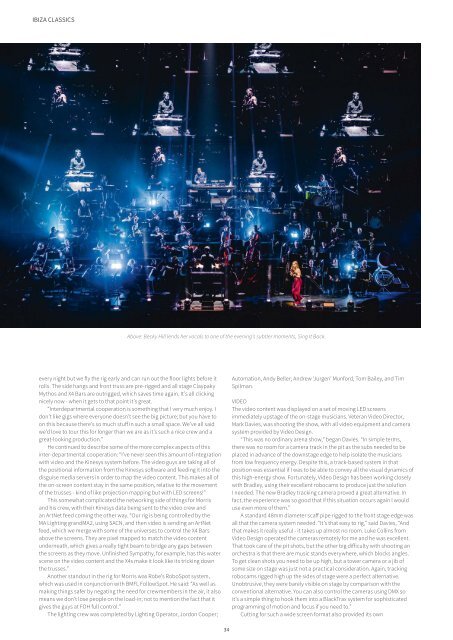Create successful ePaper yourself
Turn your PDF publications into a flip-book with our unique Google optimized e-Paper software.
IBIZA CLASSICS<br />
Above: Becky Hill lends her vocals to one of the evening’s subtler moments, Sing It Back.<br />
every night but we fly the rig early and can run out the floor lights before it<br />
rolls. The side hangs and front truss are pre-rigged and all stage Claypaky<br />
Mythos and X4 Bars are outrigged, which saves time again. It’s all clicking<br />
nicely now - when it gets to that point it’s great.<br />
“Interdepartmental cooperation is something that I very much enjoy. I<br />
don’t like gigs where everyone doesn’t see the big picture; but you have to<br />
on this because there’s so much stuff in such a small space. We’ve all said<br />
we’d love to tour this for longer than we are as it’s such a nice crew and a<br />
great-looking production.”<br />
He continued to describe some of the more complex aspects of this<br />
inter-departmental cooperation: “I’ve never seen this amount of integration<br />
with video and the Kinesys system before. The video guys are taking all of<br />
the positional information from the Kinesys software and feeding it into the<br />
disguise media servers in order to map the video content. This makes all of<br />
the on-screen content stay in the same position, relative to the movement<br />
of the trusses - kind of like projection mapping but with LED screens!”<br />
This somewhat complicated the networking side of things for Morris<br />
and his crew, with their Kinesys data being sent to the video crew and<br />
an ArtNet feed coming the other way. “Our rig is being controlled by the<br />
MA Lighting grandMA2, using SACN, and then video is sending an ArtNet<br />
feed, which we merge with some of the universes to control the X4 Bars<br />
above the screens. They are pixel mapped to match the video content<br />
underneath, which gives a really tight beam to bridge any gaps between<br />
the screens as they move. Unfinished Sympathy, for example, has this water<br />
scene on the video content and the X4s make it look like its tricking down<br />
the trusses.”<br />
Another standout in the rig for Morris was Robe’s RoboSpot system,<br />
which was used in conjunction with BMFL FollowSpot. He said: “As well as<br />
making things safer by negating the need for crewmembers in the air, it also<br />
means we don’t lose people on the load-in; not to mention the fact that it<br />
gives the guys at FOH full control.”<br />
The lighting crew was completed by Lighting Operator, Jordon Cooper;<br />
Automation, Andy Beller; Andrew ‘Jurgen’ Munford, Tom Bailey, and Tim<br />
Spilman.<br />
VIDEO<br />
The video content was displayed on a set of moving LED screens<br />
immediately upstage of the on-stage musicians. Veteran Video Director,<br />
Mark Davies, was shooting the show, with all video equipment and camera<br />
system provided by Video Design.<br />
“This was no ordinary arena show,” began Davies. “In simple terms,<br />
there was no room for a camera track in the pit as the subs needed to be<br />
placed in advance of the downstage edge to help isolate the musicians<br />
from low frequency energy. Despite this, a track-based system in that<br />
position was essential if I was to be able to convey all the visual dynamics of<br />
this high-energy show. Fortunately, Video Design has been working closely<br />
with Bradley, using their excellent robocams to produce just the solution<br />
I needed. The new Bradley tracking camera proved a great alternative. In<br />
fact, the experience was so good that if this situation occurs again I would<br />
use even more of them.”<br />
A standard 48mm diameter scaff pipe rigged to the front stage edge was<br />
all that the camera system needed. “It’s that easy to rig,” said Davies, “And<br />
that makes it really useful - it takes up almost no room. Luke Collins from<br />
Video Design operated the cameras remotely for me and he was excellent.<br />
That took care of the pit shots, but the other big difficulty with shooting an<br />
orchestra is that there are music stands everywhere, which blocks angles.<br />
To get clean shots you need to be up high, but a tower camera or a jib of<br />
some size on stage was just not a practical consideration. Again, tracking<br />
robocams rigged high up the sides of stage were a perfect alternative.<br />
Unobtrusive, they were barely visible on stage by comparison with the<br />
conventional alternative. You can also control the cameras using DMX so<br />
it’s a simple thing to hook them into a BlackTrax system for sophisticated<br />
programming of motion and focus if you need to.”<br />
Cutting for such a wide screen format also provided its own<br />
34


